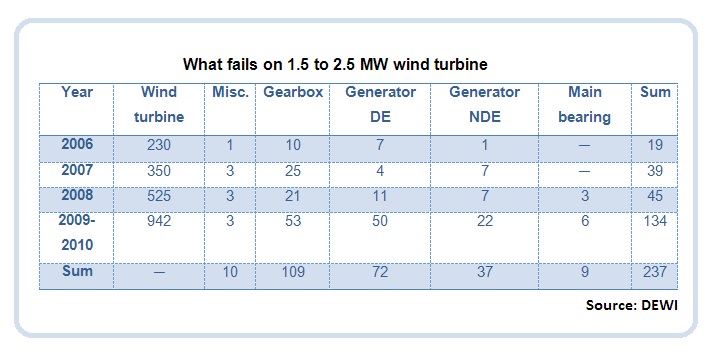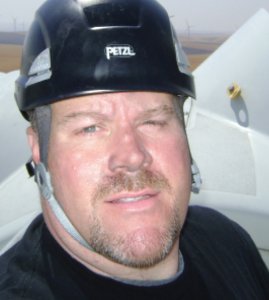David Clark / CEO / CMS Wind
The core principles of condition monitoring are fairly straightforward:
- Measure an issue
- Label the issue
- Rank the severity of the issue
- Get information to those who can fix the issue

The vibration sensors look similar but are intended for different applications. The top sensor is rated for 60 rpm while the bottom, for 12 rpm. So if the top sensor were installed near a main bearing, it might detect nothing at all.
Yet someone at most every wind-industry conference I attend makes the same negative comments about condition monitoring.
Here is the scary thing: All the problems that critics level at condition monitoring systems (CMS) are avoidable. However, they point to a larger issue, which is a lack of knowledge. So I have compiled a list of the most common complaints, misperceptions, and shortcomings levels at CMS. They are in no particular order:
- Missed detection of failures
- False alarming or too many alarms
- Spending several months to a year and more of adjusting alarms
- Not able to detect planetary gearbox issues
- Not enough lead time to failure
All these are centered on measurement set-up. The good news is these are all avoidable. The bad news: If you have these issues, it means someone needs help with the application. So let’s take these one at a time.
Problem 1 — Missed failure detections
There is a detectable fault frequency related to most driveline components in a wind turbine that is measureable using vibration sensors. However, a recent evaluation of available CMS for wind turbines found it difficult to accept this fact. Assuming the correct sensors are in the correct places, missed detections are likely caused by several issues stacked one atop the other.
Cause — Aside from the sensor issue, missed detections are likely caused by one or a combination of four things:
- An underprepared analyst (lack of vibration analysis training or a lack of application knowledge)
- An improper measurement set-up or suite of measurements
- No one looking at or analyzing the data
- Guessing at alarming
The fix — Simply reverse the above causes. That is, train the analyst, correctly measure the needed parameters with the right sensors, analyze the data, and set proper alarms.
Problem 2 — False alarms or too many of them
People often mention that they cannot keep track of or have a difficult time managing the massive amount of alarms from a new CMS installation. I have seen a few recent examples of this on good hardware and software. So the hardware and software are not the issue, it is simply set-up.
A recent site had seven alarms per tower while another site had every tower (more than 60) with every point in alarm. It is highly unlikely that every point in 60 turbines was correctly identifying an alarm. Going back to the core functions, it is likely that nothing is being accurately measured in these scenarios. Nothing was identified correctly and damage was incorrectly ranked. It is purely ineffectual.
Another CMS provider claimed he needed to staff up to handle all the alarms pouring off the monitored site. To put this into perspective, the average failure rate is actually somewhere between 10 to 16%. The failure distribution on average for a main bearing is 1 to 3% of the time, for a gearbox, slightly less than 50% of the time, and for generators, slightly less than 50% of the time. Alarms should be commensurate with these failure distributions and rates. A 20-20 rule may also be useful. That is, 20% of the site could be in alarm and 20% of those (about 5% of the site) should have progressed to a maintenance response. These percentages certainly are not the deluge that people talk about.
An improper number of alarms only drives people away from the value of CMS for wind. It also make it difficult for people on site to buy into the program.

Vibration sensors can be placed in most any location on a drive train but they work best in the locations indicated by the arrows.
Problem 3 —Taking several months to a year and more to adjust alarms
Simply put, someone is guessing where to establish alarm set points. Either a component has failed to a point that an alarm should trip …or it should not.
The other issue here is that with poor alarming decisions comes reduced lead times and missed detections. The failure distribution and rate mentioned above point to how often things fail and how quickly.
The average lead time to failures for:
- main bearings is 18 to 24 months
- planetary sections is 9 to 12 months
- high-speed shaft or internal sections is 5 to 7 months
- generators is 5 to 7 months
So if someone says it takes 9 to 12 months to establish relevant alarms, you are giving away more than half of the wind turbine’s drivetrain detection. Predictive maintenance means predicting maintenance, not guessing at it.
The fix — Establishing proper alarms is a combination of the same causes mentioned in problem one. It is really is not a difficult process but it is difficult to explain in this context. Simply put, when done correctly, it is not a guess. It does not take many months. It takes someone who understands the application and vibration analysis.
Problem 4 — Unable to detect planetary gearbox issues
One of the most repeated misperceptions is that the planetary gearbox is a mysterious black hole where problems develop, never to be seen by vibration condition monitoring. What will fail in a planetary gearbox? A bearing or a gear most likely. Mysterious? Hardly.
NREL’s Gearbox Reliability Collaborative, a database of about 300 wind turbines, showed a failure distribution of about 66% bearing and 33% gear failures. In rare instances, the gearbox case also fails precipitated by internal component failure. So gearbox measurements must be related to bearing and gear detection.
The fix — This is a combination issue caused by sensor selection, placement, and set up. All must be reviewed. A higher level of vibration-analysis understanding is required here, the lack of which contributes to the problem. While this is an easy fix, it is a complex description that is case by case.
Problem 5 — Not enough lead time to failure
The problem and the fix are the same. Address the aforementioned issues and the lead time increases on all issues, except gear-tooth cracks which are still relatively short (less than two months on average).
All these misperceptions describe wind condition monitoring as a black art or voodoo science. CMS is none of these when correctly set up. How’s it working for you? 
Filed Under: Featured, News






Condition monitoring must be a solution, not the source of more problems. Solve these 5 gearbox CMS problems easily by simply adding a gearbox oil debris monitoring sensor which integrates directly into most CMS’s, or directly to the wind turbine controller/SCADA. Alarm limits are pre-determined based on the gearbox make/model, no guessing and no expert setup/interpretation required, longest P-F intervals (months to years, typically longest lead times on the planet stage damage). The technology is not new, the pedigree is aircraft gas turbines for the last 25 years and applied to wind turbine gearboxes for the last 15 years. Standard equipment with some OEM’s and described in an ASTM standard practice (ASTM D7917-14).